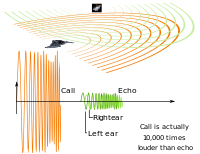
Photo from wikipedia
Delphinids produce large numbers of short duration, broadband echolocation clicks which may be useful for species classification in passive acoustic monitoring efforts. A challenge in echolocation click classification is to… Click to show full abstract
Delphinids produce large numbers of short duration, broadband echolocation clicks which may be useful for species classification in passive acoustic monitoring efforts. A challenge in echolocation click classification is to overcome the many sources of variability to recognize underlying patterns across many detections. An automated unsupervised network-based classification method was developed to simulate the approach a human analyst uses when categorizing click types: Clusters of similar clicks were identified by incorporating multiple click characteristics (spectral shape and inter-click interval distributions) to distinguish within-type from between-type variation, and identify distinct, persistent click types. Once click types were established, an algorithm for classifying novel detections using existing clusters was tested. The automated classification method was applied to a dataset of 52 million clicks detected across five monitoring sites over two years in the Gulf of Mexico (GOM). Seven distinct click types were identified, one of which is known to be associated with an acoustically identifiable delphinid (Risso’s dolphin) and six of which are not yet identified. All types occurred at multiple monitoring locations, but the relative occurrence of types varied, particularly between continental shelf and slope locations. Automatically-identified click types from autonomous seafloor recorders without verifiable species identification were compared with clicks detected on sea-surface towed hydrophone arrays in the presence of visually identified delphinid species. These comparisons suggest potential species identities for the animals producing some echolocation click types. The network-based classification method presented here is effective for rapid, unsupervised delphinid click classification across large datasets in which the click types may not be known a priori.
Journal Title: PLoS Computational Biology
Year Published: 2017
Link to full text (if available)
Share on Social Media: Sign Up to like & get
recommendations!